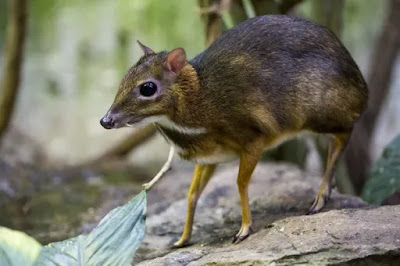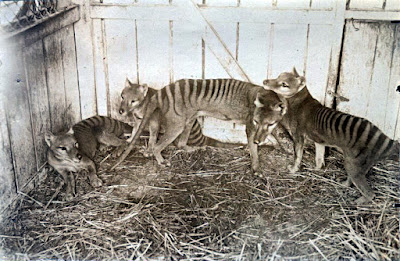We're familiar with creatures that look like a cross between two or more animals. Griffins, for example, look like they're part lion, part eagle. Today, however, we're going to discuss some real-life creatures that seem like hybrids.
Platypus
We've all heard of this one. It's sort of a beaver, sort of a duck. In fact, when Europeans first came across this bizarre beast, they thought it wasn't a real animal, but might have been created from parts of different animals by a taxidermist (much like the jackalope).
If the platypus isn't weird enough for you yet, the ankle spurs of male platypuses have venom. They have a sense of electroreception, which they use to help them hunt underwater. The platypus is also a monotreme, one of the few kinds of mammals that lay eggs. Though they produce milk for their young, they don't have teats; instead, milk seeps out of the pores of their milk patches, and is lapped up by their young.
Echidna
And as long as we're here, let's discuss the other egg-laying mammals. Behold the echidna, which seems like a cross between an anteater and a hedgehog. They even curl into a ball when threatened like a hedgehog, and their feeding habits are similar to anteaters.
And it gets weirder. Females lay a single leathery-shelled egg, which she then deposits in her pouch. Is this a monotreme or a marsupial? The egg hatches after ten days, and the baby echidna (called a puggle) remains in the pouch for about 45-55 days.
Raccoon Dog
It's a canine, but it looks like a raccoon. Because why not. Most closely related to true foxes (Vulpes genus), it's also one of the few canids who climb trees, the gray fox being the other species. They're the only canid to hibernate, and although they don't bark, they are known to whine and growl.
Fox
This one might seem odd, but stay with me for a moment. Also a type of canine, but with some curious differences. As mentioned earlier, gray foxes have been known to climb trees. True foxes, such as the red fox and fennec fox, have vertical pupils and partially retractable claws. When hunting smaller prey animals, they will often pounce on it. Red foxes have been known to leap at their prey from up to 5 m (16 ft) away, and jump over fences 2 m (6 ft 7 in) high.
So to conclude, foxes are basically cat-like canines.
Chevrotain
Also known as mouse-deer, this one is fairly self-explanatory. The smallest living ungulates, these creatures look like a cross between deer and rodent. They have no horns or antlers, and possess elongated canine teeth. These teeth are longer in males, and protrude from beneath the upper lip, creating the impression of a saber-toothed... uh, tiny deer-like thing.
Pseudoscorpion
If anything makes you want to take your shoe off and slam it against the screen, it's the next two pictures. Meet this creepy bug, which looks like some sort of mite or tick with the pincers of a scorpion. It's type of arachnid, and most species are 2-8 mm long. They pose no threat to humans, save for the fear their appearance can inspire.
Whip Spider
I really hate scorpions. But here's yet another creature that resembles one. Also called tailless whip scorpions, these guys look like a spider-scorpion hybrid. They're not venomous, but I sure don't want to see one.
Scottish Highland Cattle
Long ago, people in Great Britain decided to experiment with creating a new breed of cattle. After various crosses with cattle and Old English sheepdogs, they finally ended up with the shaggy mooing things known as the Scottish Highland cow.
Okay, not really. But considering how hairy they are, it almost seems probable. They have the longest coat of any cattle breed, and come in a variety of colors, such as red, black, brown, yellow, white, and gray.
Stick Insect
Also called stick-bugs, walking sticks, or bug sticks, these insects bear a remarkable resemblance to... well, sticks. Some have more flattened, leaf-like shapes. Their camouflage helps to protect them from predators. Many species are parthenogenic, meaning the females can lay eggs without mating. Offspring produced this way are always female, and are exact copies of their mother.
Thylacine
Also known as a Tasmanian tiger, this now-extinct marsupial looked something like a canine, but had a stiff tail like that of kangaroos, and curious stripes along their hindquarters similar to a tiger. Thylancines were one of the few marsupials in which both genders had pouches, the other species being the water opossum. They could open their jaws unusually wide, up to 80 degrees, and would give 'threat yawns' when agitated.
Echidna
And as long as we're here, let's discuss the other egg-laying mammals. Behold the echidna, which seems like a cross between an anteater and a hedgehog. They even curl into a ball when threatened like a hedgehog, and their feeding habits are similar to anteaters.
And it gets weirder. Females lay a single leathery-shelled egg, which she then deposits in her pouch. Is this a monotreme or a marsupial? The egg hatches after ten days, and the baby echidna (called a puggle) remains in the pouch for about 45-55 days.
 |
| A short-beaked echidna. |
Raccoon Dog
It's a canine, but it looks like a raccoon. Because why not. Most closely related to true foxes (Vulpes genus), it's also one of the few canids who climb trees, the gray fox being the other species. They're the only canid to hibernate, and although they don't bark, they are known to whine and growl.
Fox
This one might seem odd, but stay with me for a moment. Also a type of canine, but with some curious differences. As mentioned earlier, gray foxes have been known to climb trees. True foxes, such as the red fox and fennec fox, have vertical pupils and partially retractable claws. When hunting smaller prey animals, they will often pounce on it. Red foxes have been known to leap at their prey from up to 5 m (16 ft) away, and jump over fences 2 m (6 ft 7 in) high.
So to conclude, foxes are basically cat-like canines.
Chevrotain
Also known as mouse-deer, this one is fairly self-explanatory. The smallest living ungulates, these creatures look like a cross between deer and rodent. They have no horns or antlers, and possess elongated canine teeth. These teeth are longer in males, and protrude from beneath the upper lip, creating the impression of a saber-toothed... uh, tiny deer-like thing.
 |
| Male Java mouse-deer. |
Pseudoscorpion
If anything makes you want to take your shoe off and slam it against the screen, it's the next two pictures. Meet this creepy bug, which looks like some sort of mite or tick with the pincers of a scorpion. It's type of arachnid, and most species are 2-8 mm long. They pose no threat to humans, save for the fear their appearance can inspire.
Whip Spider
I really hate scorpions. But here's yet another creature that resembles one. Also called tailless whip scorpions, these guys look like a spider-scorpion hybrid. They're not venomous, but I sure don't want to see one.
Scottish Highland Cattle
Long ago, people in Great Britain decided to experiment with creating a new breed of cattle. After various crosses with cattle and Old English sheepdogs, they finally ended up with the shaggy mooing things known as the Scottish Highland cow.
Okay, not really. But considering how hairy they are, it almost seems probable. They have the longest coat of any cattle breed, and come in a variety of colors, such as red, black, brown, yellow, white, and gray.
Stick Insect
Also called stick-bugs, walking sticks, or bug sticks, these insects bear a remarkable resemblance to... well, sticks. Some have more flattened, leaf-like shapes. Their camouflage helps to protect them from predators. Many species are parthenogenic, meaning the females can lay eggs without mating. Offspring produced this way are always female, and are exact copies of their mother.
Thylacine
Also known as a Tasmanian tiger, this now-extinct marsupial looked something like a canine, but had a stiff tail like that of kangaroos, and curious stripes along their hindquarters similar to a tiger. Thylancines were one of the few marsupials in which both genders had pouches, the other species being the water opossum. They could open their jaws unusually wide, up to 80 degrees, and would give 'threat yawns' when agitated.








No comments:
Post a Comment